28 Jun 2022 - {{hitsCtrl.values.hits}}

The industry must plan their cash flows around revenue generated by the few tourists who are around, and manage their recurrent expenditure as much as possible
 The unprecedented economic collapse is wreaking havoc across the social economic landscape of Sri Lanka. All industries are suffering, with front end industries like tourism carrying the brunt. And tourism is no stranger to crises, having had to face multiple setbacks, time and again, over the last 30 -40 years.
The unprecedented economic collapse is wreaking havoc across the social economic landscape of Sri Lanka. All industries are suffering, with front end industries like tourism carrying the brunt. And tourism is no stranger to crises, having had to face multiple setbacks, time and again, over the last 30 -40 years.
However, this time around there is no security risk to any tourists unlike before. It’s the national economic problem with non-availability of essentials that is disrupting everything. Hotel operations are immensely difficult to maintain, and the quality of product and service offering is deteriorating.
All this only causing inconvenience to tourists. There are absolutely no issues with security. Actually the few tourists who are around only feel sorry for Sri Lankans.
But, there is also a growing guilt conscience among tourists, to see the country’s citizens suffering, while they have a good time holidaying in a hotel. So would a tourist, spend his hard earned savings and have a holiday in Sri Lanka, when all around them what they see is hardship and suffering? Therefore many tourists are now having second thoughts of visiting Sri Lanka, and arrivals are rapidly diminishing.
The only silver lining is that it is currently the off season in the west and south of the country where traditionally there is relatively low occupancy in any case. The east coast, which should be in high season now, is having very poor occupancy.
Current status of the industry
In the meantime, tourism operators are currently in dire straits with very little revenues due to reduced occupancy, and dramatically increasing operational costs. Shortages in essential operational items is wreaking havoc in providing quality service to tourists.
Sri Lankan hotels are now in a critical stage with time running out on the June deadline for moratoriums. If an extension is not granted they will face an imminent collapse with layoffs and complete shutdown of the industry.
In addition, there is the new social fund tax imposed at the rate of 2.5 percent for importers, manufacturers, service providers, wholesalers and retailerswhich will also have a big impact on the tourism industry. However, on the face of it, the tourism industry should be rightly considered an export industry and be exempted of this tax.
Therefore, there are major challenges that the industry will have to face, and withstand, if they are to see better days in the future.
Future of tourism
If the ground situation returns to some normalcy, and the supply of essential commodities are somewhat relieved, then definitely tourism will bounce back fast in Sri Lanka. There is no question of that. This is one industry which has the ability to recover very rapidly.
The million rupee question is when will ‘normalcy’ return? It is totally a national problem over which the tourism industry has no control of. As things are, according to predictions of many professionals this situation will get worse in the months to come. But there may be some resolution by the end of the year
Consequently, it follows that one cannot expect any great tourist movements to take place this year. Hence its best that the tourism industry understands this and accepts the grim reality, instead of keeping false hope.
Once the reality have been accepted, it is then easy to make plans to meet the situation and strategize how to mitigate, at least in some way, the impact. The industry must plan their cash flows around revenue generated by the few tourists who are around, and manage their recurrent expenditure as much as possible. Staff must be retained but properly communicated to, and some salary cut backs negotiated.
In this context, it was good to see the stakeholders, the PM and Minister all of one mind to establish a pragmatic target of 800,000 arrivals for the year and focus on the ‘low hanging fruit’ such as the Indian market in the short term.
(The writer is an ex-President of The Hotels Association of Sri Lanka)
27 Dec 2024 17 minute ago
27 Dec 2024 49 minute ago
27 Dec 2024 1 hours ago
27 Dec 2024 3 hours ago
27 Dec 2024 3 hours ago